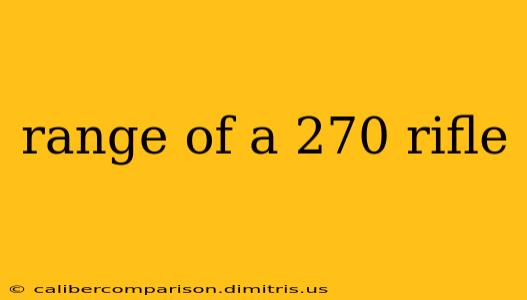The .270 Winchester is a popular hunting cartridge known for its accuracy and power, making it a favorite among hunters pursuing a wide range of game. However, understanding the effective range of a .270 rifle is crucial for safe and ethical hunting practices. This isn't simply about the maximum distance a bullet can travel; it's about the distance at which a hunter can reliably and accurately place a shot for a clean kill.
Factors Affecting .270 Rifle Range
Several factors influence the effective range of a .270 Winchester rifle:
1. Ballistics: Bullet Type and Weight
The bullet's weight, ballistic coefficient (BC), and design significantly impact its trajectory and energy retention over distance. Heavier bullets with a higher BC generally retain more velocity and energy at longer ranges, extending effective range. Conversely, lighter bullets experience greater drop and energy loss, limiting their effective range. Different bullet types (e.g., spitzer, boat-tail) also affect their flight characteristics.
2. Rifle and Scope Quality
The rifle's accuracy and the quality of the scope play a critical role. A high-quality rifle with a precisely-fitted barrel will shoot more accurately than a lower-quality one. Similarly, a high-quality scope with clear optics and accurate adjustments is essential for precise aiming at longer ranges. Proper scope zeroing is absolutely critical for accurate shots.
3. Environmental Conditions
Wind, temperature, and humidity can dramatically affect bullet trajectory. Strong winds can significantly deflect a bullet's path, making long-range shots less predictable. Temperature affects the air density, influencing the bullet's speed and trajectory. Humidity can also play a role in altering air density. Experienced hunters use ballistic calculators to account for these variables.
4. Shooter Skill and Experience
The shooter's skill and experience are perhaps the most significant factor influencing effective range. A skilled marksman with proper training and practice can consistently make accurate shots at longer ranges than a less experienced shooter. Factors like proper breathing, stance, and trigger control contribute to accurate shooting.
Defining "Effective Range" for a .270 Winchester
The effective range of a .270 Winchester is generally considered to be between 300 and 500 yards for most hunting situations. Beyond this distance, several factors come into play:
- Energy Drop-off: The bullet's energy decreases significantly at longer ranges, potentially leading to less humane kills and reduced penetration.
- Trajectory Drop: Bullet drop becomes increasingly difficult to compensate for at longer ranges, requiring precise estimations and adjustments.
- Wind Drift: Wind becomes a major factor affecting accuracy at longer ranges.
- Shot Placement: The margin for error in shot placement shrinks considerably at longer distances, increasing the chances of a non-lethal hit.
Maximum Range vs. Effective Range
It's important to differentiate between the maximum range and the effective range. The maximum range refers to the distance a bullet can physically travel before hitting the ground. This can be significantly further than the effective range and is not a relevant measure for ethical hunting. The effective range is the distance at which a hunter can reliably and accurately place a shot for a humane kill.
Conclusion: Responsible Hunting Practices
While a .270 Winchester can reach impressive distances, responsible hunters prioritize ethical and humane kills. Understanding the limitations of effective range and the factors influencing it is crucial for ensuring successful and ethical hunting practices. Always practice safe shooting techniques and consider the environmental conditions and your own skill level before taking a long-range shot. Choosing the right ammunition for the specific hunting situation is also paramount. Remember, shot placement is paramount, and ethical hunting should always be the priority.

